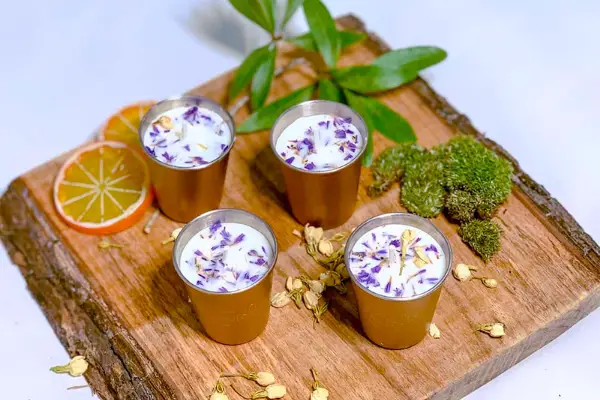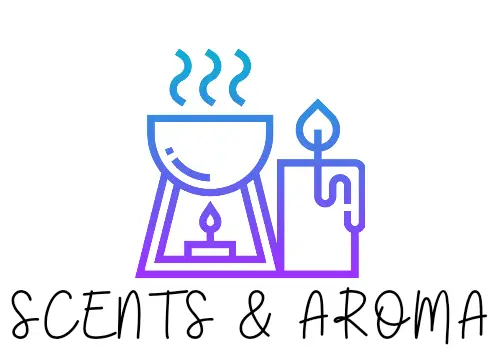Imagine a quiet evening surrounded by scented candles with enough aromas to add ambiance and freshness to your space. Scented candles have numerous health benefits. So much that most people have switched from chemical-based fragrances to more natural ones. But is it safe to put dried flowers in candles?

The risk of a fire hazard is one of the most significant issues with putting in a flower candle. Of course, dried flowers or herbs add scent and pop or color to candles. However, putting dried flowers directly beside the wick is fuel for the fire.
So, is it safe to put dried flowers in candles?
It is safe to put dried flowers in your candles, depending on the flower type and experience. You must position the flowers correctly, or as we’ve mentioned, or you will risk a fire hazard. For example, you must place the flowers closer to the sides of the candles and away from the wick. As long as the flowers don’t come into direct contact with the candlewick when it is lit, it is safe.
The crucial thing to hold on to with this debate is “if you know how to.” So far, we have established that it is safe to put dried flowers in candles. However, only do it if you know how to do so.
Before we begin have a look at this candle with dried flowers (opens in a new window) so that you get an idea of what I am talking about in this article.
How to put dried flowers in candle
Here are some simple to follow steps that you can use to put flowers into your candles.
If you would like some recommendations of dried flowers to use, these variety packs available on Amazon are awesome!
Determine the type of flowers
Dried plant matter near the flame can be dangerous. So, if you want to, you must use flowers that offer real health benefits. For example, flowers or herbs used in aromatherapy adds fragrance inside your home. Although different herbs and flowers work for aromatherapy, let us examine a few of them.
- Rosemary: You can use rosemary as a design and for fragrance
- Lavender: lavender is a popular choice for candles. The herb reduces anxiety and triggers calmness.
- Chamomile: Chamomile is another herb that adds decorative and aromatic value to your candle.
- Mint: use either peppermint or spearmint for a fresh and clean minty fragrance.
- Lemon verbena: use the lemon verbena for a fresh citrus scent.
- You can also use sage, lemongrass, thyme, licorice, etc.
There is no end to the type of flower you can use. It mostly depends on your preference and taste. However, make sure it releases a fresh and herbal aroma. In essence, the flower must not trigger an adverse reaction or cause health problems.
Get your flower preparations right
Don’t just place a wide and whole dry flower on your candle. Instead, do the following:
- Chop or grind your dry flowers into small and fine pieces: large flower pieces will attract flame. They also make the candle and the entire procedure more dangerous. Therefore, chop or grind them into fine pieces before using them for candles.
- Use a large container: only add flowers to a candle in a large container. Jars with a wide diameter let you keep the flowers closer to the wall of the container and as far away from the wick as possible.
- Don’t place dry flowers directly on top of the candles that are ready to use
- Only add dried flowers to molten wax during the candle-making process. This allows the herbs to sink while the candle melts. It also eliminates the risk of an open fire.
Make your candle and add the flowers
So, let us all assume you are a beginner that doesn’t know much about candle making. If you are not a newbie, you can skip the many procedures and jump to the part about adding the flowers.
Gather your supplies
Depending on the type of flower you want, gather your supplies. The common ones are:
- Candle wax (Use this guide to help you decide which wax to use).
- Candle wicks (cotton wicks vs woodwicks, the choice is yours)
- Essential oils
- Dried flowers
- Wooden skewers
- Any other thing you use to make your candle
Measure the wax
Measure the quantity of wax since the flakes are not yet melted. Since there are different types of candle waxes, you can choose any type you want. However, we recommend environmentally-friendly ones like coconut wax, beeswax, and soy wax.
Melt the wax, add fragrance or essential oils, and the wick
On a stovetop, melt your wax in a saucepan. Then, add fragrance or essential oil to the melted wax. After that, secure the wicks to the bottom of the container and pour the melted wax.
If you know about the candle-making process, jump to this step.
- Pour your hot wax into a container. Then, sprinkle your crushed or chopped dried flowers around the wax.
- Sprinkle your flower close to the outer edge of the jar away from the wick. Ensure that the wick is about half an inch in diameter away from the nearest herb. The flower will sink into the molten wax.
- If you want, pour your wax in layers and sprinkle the flowers in layers also. Instead of sitting at the bottom, your flowers will be suspended within the candle height.
- Let each layer start thickening before adding more flowers on top. Continue this process until you fill the container.
- If you plan to use more than one type of flower, set them in layers. For example, thyme at the bottom, rosemary at the middle, and lavender at the top.
Take precautions to avoid candle sinkholes. You can check our article on why homemade candles sink in the middle for more insights.
Conclusion
Dry flowers can burst into smoldering or sporadic flames when they come in contact with a lit wick. As a result, you must be careful with the entire procedure. But not to dampen your freshness and relaxation efforts, you can still enjoy the sweet and fresh aroma of flowers in your candles.
Bear in mind, don’t add dry leaves as a whole on your ready-to-use candle. Instead, chop the flowers into bits and layer them into the molten wax away from the wick. Take this precaution and you won’t have any problem.
- Can You Put Perfume In A Humidifier? (Read First) - September 17, 2022
- Can You Put Essential Oil In A Steam Mop? (Safety Advice) - September 17, 2022
- How To Make Lavender Oil At Home ( Candles And Diffusers) - September 9, 2022
